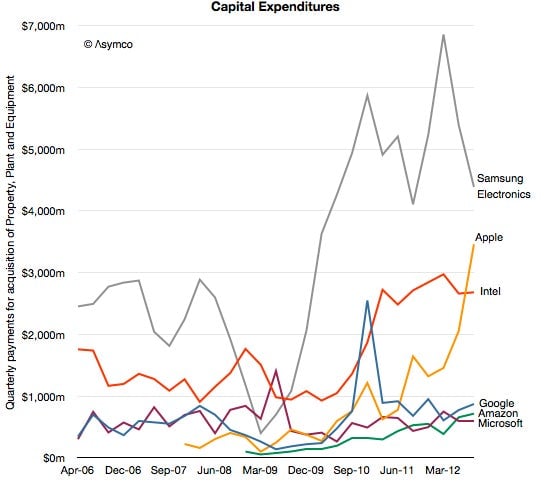Google is waging a financial war of attrition to win the cloud
Google is fighting a war on multiple fronts—against Apple, Amazon, Microsoft, and others—and is outspending them all in the one area that will be critical to winning the future: the cloud.


Google is fighting a war on multiple fronts—against Apple, Amazon, Microsoft, and others—and is outspending them all in the one area that will be critical to winning the future: the cloud.
Google’s April 17 earnings report revealed that the company spent $2.35 billion on infrastructure, which for Google means its data centers and all the IT gear that go in them.
Let’s put that in historical perspective. This chart from ex-Nokia analyst Horace Dediu is two years old, but it nicely illustrates the trend in infrastructure spending at the major consumer “cloud” companies before the recent frenzy.

Note that in the two years since Dediu assembled this data, Google has more than doubled its infrastructure spending, an increase of more than a billion dollars per quarter. Google is now on track to spend $10 billion a year building an outfitting data centers. To put that in perspective, that’s only $1 billion short of what Intel and Samsung will each spend to build and update the enormously expensive, ultra high tech factories, called chip fabs, where microprocessors are made.
How does Google’s spending on cloud infrastructure compare to its rivals? Amazon doesn’t break out what it spends solely on its cloud infrastructure, but the total value of “purchases of property and equipment, including internal-use software and website development” for all of Amazon was $1.08 billion in its most recent quarter, and Microsoft’s “additions to property and equipment” amounted to $1.73 billion.
Meanwhile, Apple spent $3.37 billion on infrastructure last quarter, but that number is meaningless in this context because, famously, most of that is for factories to build all those shiny iThings. We have no idea what portion of that goes to data centers, and in any event Apple is hardly a cloud-centric company.
But here’s the point: The cloud is at the center of Google’s strategy to push back against all its competitors.
Take Apple. Google just got out of the phone manufacturing business, so it can compete against Apple, through Android, without actually making any hardware. It has countless partners, like Samsung, to take on that unenviable task.
Now look at Microsoft. Google Apps is making inroads among small businesses.
And Amazon is a direct competitor to Google in the cloud-services market. While Amazon might have a tremendous head start, Google is apparently willing to outspend the company on every front.
What do all three of these battles have in common? In mobile, enterprise and services, Google is able to leverage its tremendous cloud infrastructure. Sure, it’s selling or giving away three different things—a mobile ecosystem, cloud-based software, or actual cloud services. But all three are enabled by the same cloud infrastructure.
Google is now spending more on the cloud than, well, anyone. And with the company getting serious about renting out portions of that cloud to others, in a so-called “public cloud,” it represents serious competition for Amazon, which as of 2013 had a public cloud five times larger than its next 14 competitors combined.
It will take a while for Google’s public cloud to gain steam, but it’s already having an impact. Snapchat runs on it, and, as Leo Leung of cloud services company Oxygen Cloud noted in a recent post:
Despite our heavy use of [Amazon Web Services], Google’s Cloud Platform (App Engine in particular), has changed the game for my company in terms of reducing development and deployment overhead. With Google’s infrastructure prices now more in line, our first choice has become [Google].
It’s apparent that Google is now, as much as anything, a company whose competitive advantage is infrastructure as much as the products into which that infrastructure is transformed. And Google is a company still deriving its revenue overwhelmingly from search and advertising—which means it can afford to wage a no-profit war of attrition for as long as it takes.